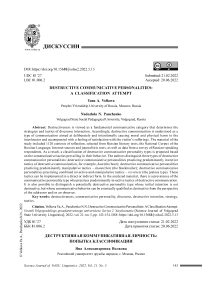Destructive communicative personalities: a classification attempt
Автор: Volkova Yana A., Panchenko Nadezhda N.
Журнал: Вестник Волгоградского государственного университета. Серия 2: Языкознание @jvolsu-linguistics
Рубрика: Дискуссии
Статья в выпуске: 5 т.21, 2022 года.
Бесплатный доступ
Destructiveness is viewed as a fundamental communicative category that determines the strategies and tactics of discourse interaction. Accordingly, destructive communication is understood as a type of communication aimed at deliberately and intentionally causing moral and physical harm to the interlocutor and accompanied with a feeling of satisfaction with the victim’s sufferings. The material of the study included 1120 contexts of reflection, selected from Russian literary texts, the National Corpus of the Russian Language, Internet sources and journalistic texts, as well as data from a survey of Russian-speaking respondents. As a result, a classification of destructive communicative personality types is proposed based on the communicative tactics prevailing in their behavior. The authors distinguish three types of destructive communicative personalities: destructive communicative personalities practicing predominantly invective tactics of destructive communication, for example, ham (the boor); destructive communicative personalities practicing predominantly manipulative tactics - shantazhist (the blackmailer); destructive communicative personalities practicing combined invective-and-manipulative tactics - revnivets (the jealous type). These tactics can be implemented in a direct or indirect form. In the analyzed material, there is a prevalence of the communicative personality type who practices predominantly invective tactics of destructive communication. It is also possible to distinguish a potentially destructive personality type whose initial intention is not destructive, but whose communicative behavior can be eventually qualified as destructive from the perspective of the addresser and/or an observer.
Destructiveness, communicative personality, discourse, destructive intention, strategy, tactics
Короткий адрес: https://sciup.org/149141038
IDR: 149141038 | DOI: 10.15688/jvolsu2.2022.5.13
Список литературы Destructive communicative personalities: a classification attempt
- Bogin G.I., 1975. Urovni i komponenty rechevoy sposobnosti cheloveka [Levels and Components of Human Speech Ability]. Kalinin, Izd-vo Kalinin. gos. un-ta. 106 p.
- Dovlatov S.D. Eto neperevodimoye slovo «khamstvo» [This is an Untranslatable Word "Rudeness"]. URL: http://www. sergeidovlatov. com/books/ etoneper.html
- Issers O.S., 2008. Kommunikativnye strategii i taktiki russkoy rechi [Communication Strategies and Tactics of Russian Speech]. Moscow, LKI. 288 p.
- Karasik V.I., 2002. Yazykovoy krug: lichnost, kontsepty, diskurs [Language Circle: Personality, Concepts, Discourse]. Volgograd, Peremena Publ. 477 p.
- Karasik V.I., 2007. Yazykovyye klyuchi [Language Keys]. Volgograd, Paradigma Publ. 520 p.
- Karaulov Yu.N., 1987. Russkiy yazyk i yazykovaya lichnost [Russian Language and Language Personality]. Moscow, Nauka Publ. 261 p.
- Krasnykh VV, 2001. Osnovy psikholingvistiki i teorii kommunikatsii [Fundamentals of Psycholinguistics and Communication Theory]. Moscow, Gnozis Publ. 270 p.
- Panchenko N.N., 2008. Kommunikativnyy tipazh «demagog» [Communicative Type "Demagogue"].
- Izvestiya Volgogradskogo gosudarstvennogo pedagogicheskogo universiteta [Bulletin of the Volgograd State Pedagogical University], no. 5 (29), pp. 56-60.
- Puzyrev A.V., 2002. Opyty tselostno-sistemnykh podkhodov k yazykovoy i neyazykovoy realnosti [Experiences of Holistic-Systemic Approaches to Linguistic and Non-Linguistic Reality]. Penza, PGPU im. VG. Belinskogo. 164 p.
- Romek V.G., 2004. Khamstvo nepobedimo? [Is Rudeness Invincible?] Sotsialnyy psikholog [Social Psychologist], no. 1 (7). URL: https:// www.romek.ru/ru/hamstvo 1
- Sedov K.F., 2004. Diskurs i lichnost: evolyutsiya kommunikativnoy kompetentsii [Discourse and Personality: The Evolution of Communicative Competence]. Moscow, Labirint Publ. 320 p.
- Sedov K.F., 2008. Teoreticheskaya model psikholingvopersonologii [Theoretical Model of Psycholinguopersonology]. Voprosy psikholingvistiki [Questions of Psy-cholinguistics], no. 7, pp. 12-23.
- Sirotinina O.B., 1998. Sotsiolingvisticheskiy faktor v stanovlenii yazykovoy lichnosti [Sociolinguistic Factor in the Formation of a Linguistic Personality]. Yazykovaya lichnost: sotsio-lingvisticheskiye i emotivnyye aspekty [Language Personality: Sociolinguistic and Emotive Aspects]. Volgograd, Peremena Publ., pp. 3-9.
- Volkova Ya.A., 2012. Destruktivnoye obshcheniye: k opredeleniyu ponyatiya [Destructive Communication: To the Definition of the Concept]. Vestnik Volgogradskogo gosudarstvennogo universiteta. Seriya 2. Yazykoznanie [Science Journal of Volgograd State University. Linguistics], no. 2 (16), pp. 205-219.
- Volkova Ya.A., 2014. Destruktivnoe obshhenie v kognitivno-diskursivnom aspekte [Destructive Communication in Cognitive and Discourse Aspects]. Volgograd, Peremena Publ. 304 p.
- Vorkachev S.G., 2001. Lingvokulturologiya, yazykovaya lichnost, kontsept: stanovleniye antropotsentricheskoy paradigmy v yazykoznanii [Linguoculturology, Linguistic Personality, Concept: The Formation of an Anthropocentric Paradigm in Linguistics]. Filologicheskiye nauki [Philological Sciences], no. 1, pp. 64-72.


